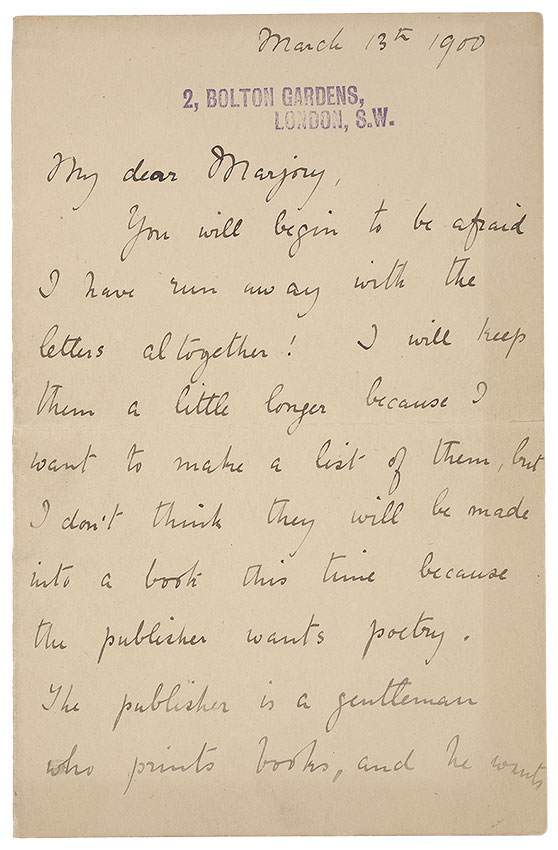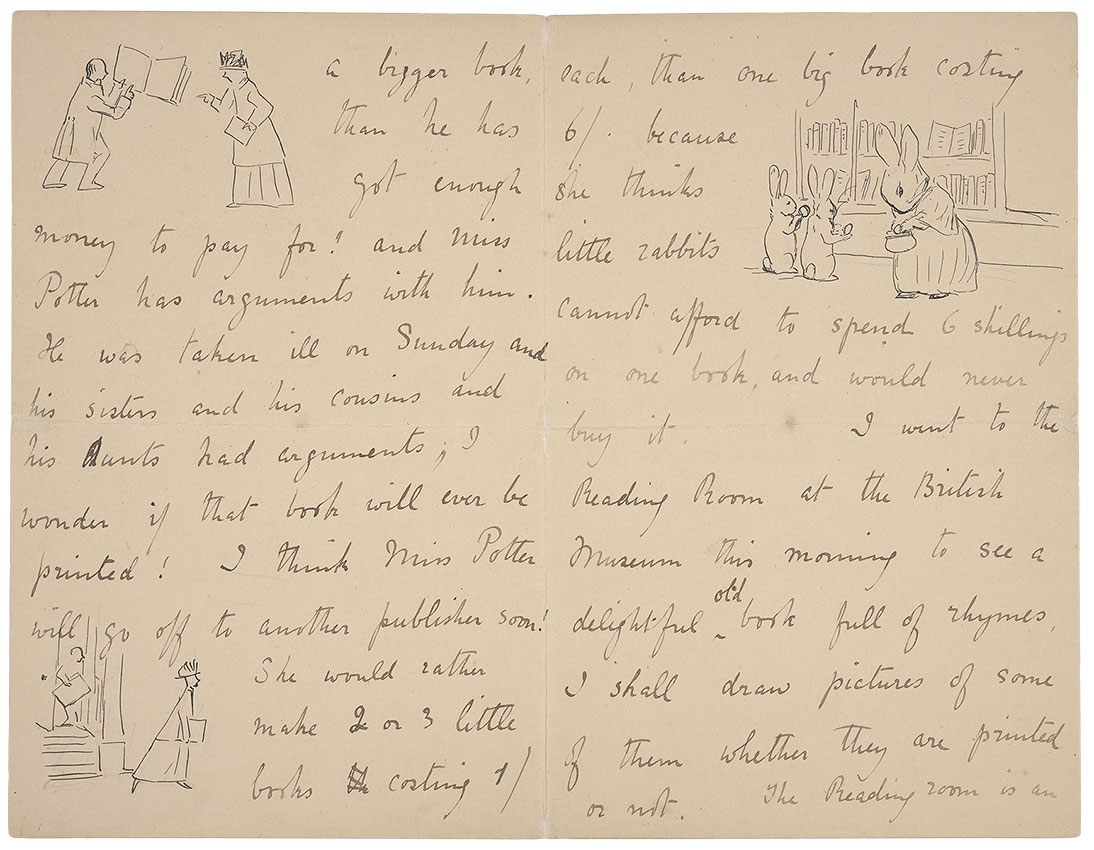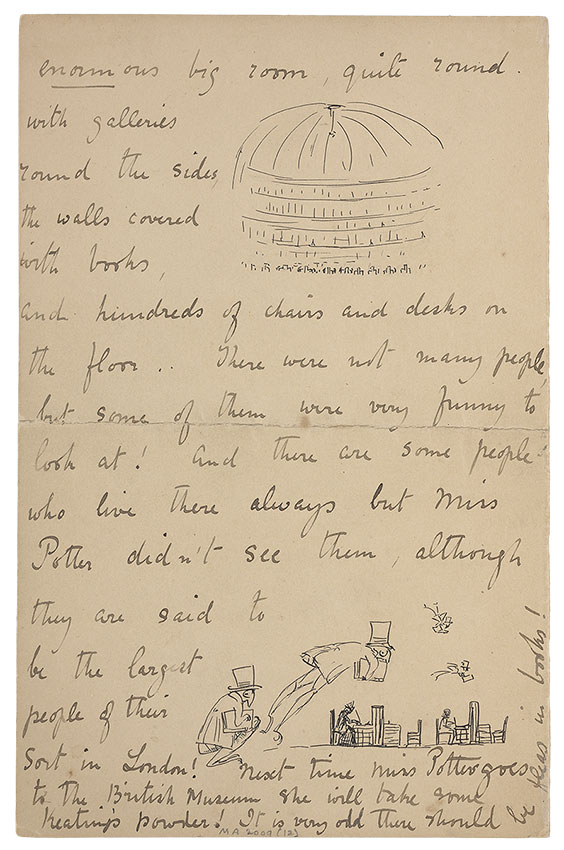March 13, 1900 page 1

Autograph letter, London, to Marjorie Moore, March 13, 1900
Gift of Colonel David McC. McKell, 1959
Around 1900 Potter began to explore the possibility of making commercial publications out of the stories she had written in her picture letters. She borrowed them back from the children and decided to start with Peter Rabbit. Eight pages long, each episode accompanied with an illustration, that letter most obviously had the makings of a book. (The original is now on deposit at the Victoria & Albert Museum.) The publication process was frustrating and arduous, partly because publishers did not understand what she was trying to achieve and partly because she disagreed with them about publishing techniques. Here she confided to a younger sister of Noel Moore that negotiations were not going well and that she might have to try again with another firm. One of the sticking points was the price and size of the book, the publisher arguing for a larger and more expensive product, the author demanding something smaller and cheaper, a booklet "little rabbits" could afford. Eventually she got her way and succeeded in setting modest prices for a book in a smaller format, an endearing feature of the Peter Rabbit series to this day.
My dear Marjory,
You will begin to be afraid I have run away with the letters altogether! I will keep them a little longer because I want to make a list of them, but I don't think they will be made into a book this time because the publisher wants poetry. The publisher is a gentleman who prints books, and he wants
March 13, 1900, page 2–3

Autograph letter, London, to Marjorie Moore, March 13, 1900
Gift of Colonel David McC. McKell, 1959
Around 1900 Potter began to explore the possibility of making commercial publications out of the stories she had written in her picture letters. She borrowed them back from the children and decided to start with Peter Rabbit. Eight pages long, each episode accompanied with an illustration, that letter most obviously had the makings of a book. (The original is now on deposit at the Victoria & Albert Museum.) The publication process was frustrating and arduous, partly because publishers did not understand what she was trying to achieve and partly because she disagreed with them about publishing techniques. Here she confided to a younger sister of Noel Moore that negotiations were not going well and that she might have to try again with another firm. One of the sticking points was the price and size of the book, the publisher arguing for a larger and more expensive product, the author demanding something smaller and cheaper, a booklet "little rabbits" could afford. Eventually she got her way and succeeded in setting modest prices for a book in a smaller format, an endearing feature of the Peter Rabbit series to this day.
a bigger book than he has got enough money to pay for! and Miss Potter has arguments with him. He was taken ill on Sunday and his sisters and his cousins and his aunts had arguments; I wonder if that book will ever be printed! I think Miss Potter will go off to another publisher soon! She would rather make 2 or 3 little books costing 1/ each, than one big book costing 6/ because she thinks little rabbits cannot afford to spend 6 shillings on one book, and would never buy it.
I went to the Reading Room at the British Museum this morning to see a delightful old book full of rhymes. I shall draw pictures of some of them whether they are printed or not. The Reading Room is an
March 13, 1900, page 4

Autograph letter, London, to Marjorie Moore, March 13, 1900
Gift of Colonel David McC. McKell, 1959
Around 1900 Potter began to explore the possibility of making commercial publications out of the stories she had written in her picture letters. She borrowed them back from the children and decided to start with Peter Rabbit. Eight pages long, each episode accompanied with an illustration, that letter most obviously had the makings of a book. (The original is now on deposit at the Victoria & Albert Museum.) The publication process was frustrating and arduous, partly because publishers did not understand what she was trying to achieve and partly because she disagreed with them about publishing techniques. Here she confided to a younger sister of Noel Moore that negotiations were not going well and that she might have to try again with another firm. One of the sticking points was the price and size of the book, the publisher arguing for a larger and more expensive product, the author demanding something smaller and cheaper, a booklet "little rabbits" could afford. Eventually she got her way and succeeded in setting modest prices for a book in a smaller format, an endearing feature of the Peter Rabbit series to this day.
enormous big room, quite round, with galleries round the sides, the walls covered with books, and hundreds of chairs and desks on the floor. There were not many people, but some of them were very funny to look at! And there are some people who live there always but Miss Potter didn't see them, although they are said to be the largest people of their sort in London! Next time Miss Potter goes to the British Museum she will take some Keating's powder. It is very odd that there should be fleas in books!